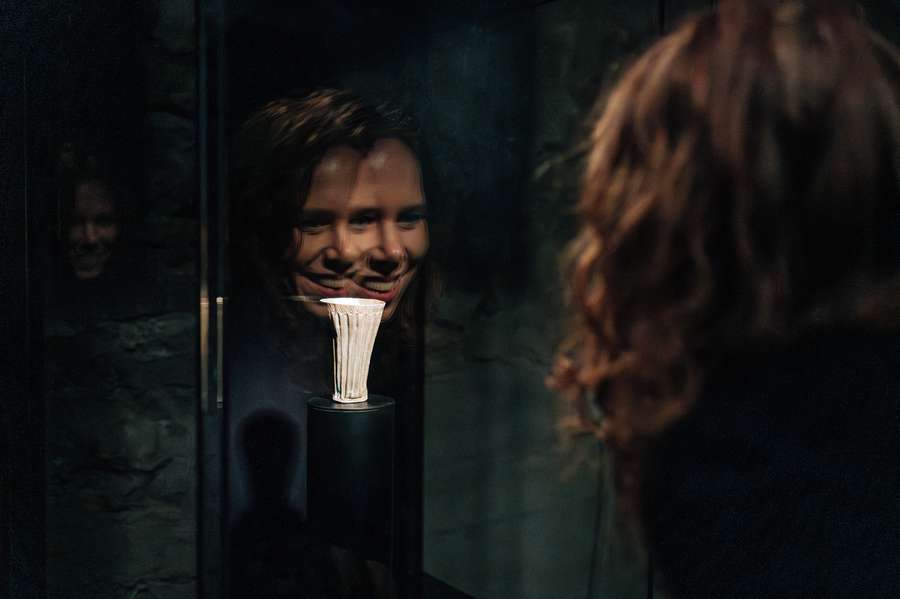The silver beaker from a castle table setting
Treasure from the medival castle on top of Jeterbenk
The Silver Beaker was found on the northern slope of Jeterbenk Hill, not far from the remains of the towered castle of the Spanheim ministerials, the Hertenbergers.
Based on findings of small objects of material culture from archaeological deposits, it can be inferred that in medieval urban settlements and castles, eating and drinking vessels made of wood, ceramics, and glass were primarily in use. On the other hand, various depictions, descriptions in castle inventories, inheritance documents, and lists of wedding gifts reveal that vessels made of precious metals were also not uncommon in these environments. Like jewellery, these were mainly valued for their material worth. Both types of movable goods were considered significant investments, hence these items were pawned, sold, and melted down. It is apparent that this is also the main reason why archaeological finds of silverware from the high and late Middle Ages are extremely rare and typically represented in so-called hoard or treasure finds. According to some estimates, less than one percent of precious medieval metal vessels have survived. Excluding sacred items from church treasuries, only about 60 profane silver vessels are documented among Central European material.
By fortunate chance, we can present one such silver vessel from the medieval region of Carniola. The beaker, with densely spaced vertical ribs on its walls and adorned with incised triangular motifs on its rim and base, resembles the shape of glass cups from the so-called Venetian tradition, typical of urban and castle settings in Central Europe from the second half of the 13th century and the first half of the 14th century. Based on the object's weight (approximately 100 grams) and high silver purity (99.8%), it can be inferred that an ingot, cast in a mining smelter, was likely used for crafting the beaker, while the ornamentation strongly suggests a goldsmith's workshop in Carniola.
The Silver Beaker was found on the northern slope of Jeterbenk Hill, not far from the remains of the towered castle of the Spanheim ministerials, the Hertenbergers. It is a part of a complex of three castles south of Medvode, consisting of the Old Jeterbenk (Alt Hertenberch), New Jeterbenk (New Hertenberch), and the Nebojsa Tower (Neboyz). All three castles were described as abandoned as early as 1344.
The beaker was discovered in March 1986 during the clearing of wood after a winter ice storm by the landowner, Gabrijel Čarman from Ravanski grič in Žlebe. Lado Vidmar from the Tourist Society Žlebe - Marjeta recognized its broader significance and informed Dr. Andrej Gaspari about it. Gaspari, along with students from the Department of Archaeology at the Faculty of Arts, conducted research on the Jeterbenk fortifications from 2018 to 2021. Through his intervention and with financial assistance from the Ministry of Culture, which provided funds for the finder's reward, the vessel became part of the MGML medieval collection in September 2023. The details of the discovery do not offer concrete support for conclusions about how the beaker ended up on the steep slope below the castle's defensive moat atop Jeterbenk. Nevertheless, based on its chronology and nature, it can be identified as part of the castle inventory or events directly linked to the tower in the second half of the 13th or early 14th century.
Did you know?
Jeterbenk is a 774 m high hill in the Polhov Gradec Hills, situated between Slavkov dom on Golo Brdo and the villages of Topol or Katarina. Numerous marked hiking trails lead to it, one of which will take you along the path of the robber knights.
Colophon
Production: Muzej in galerije mesta Ljubljane
Curator: Martin Horvat
Text: dr. Andrej Gaspari, Martin Horvat; summarized from the article A. Gaspari, Precious beaker of the Hertenberg knights from the Jeterbenk hill near Medvode (Slovenia). Beiträge zur Mittelalterarchäologie in Österreich 40, 2024
Producer and coordination: Ana Modic, dr. Bernarda Županek
Photo: dr. Andrej Gaspari
Drawing and visualisation: Blaž Kumer
Conservation interventions: Helena Pucelj Krajnc
Promotion: Urša Karer, Ana Kure
Graphic design: Bojan Lazarević, Agora Proars
Exhibition production and layout: O. K. VIR, MGML Technical Services
Location
Gosposka 15
1000 Ljubljana
Information and reservations:
T: +386 1 2412 500
T: +386 1 2412 506
E- mail: info@mgml.si, prijava@mgml.si
Opening hours
Tuesday–Sunday: 10.00–18.00
Mondays, 1 January, 1 November and 25 December: Closed
